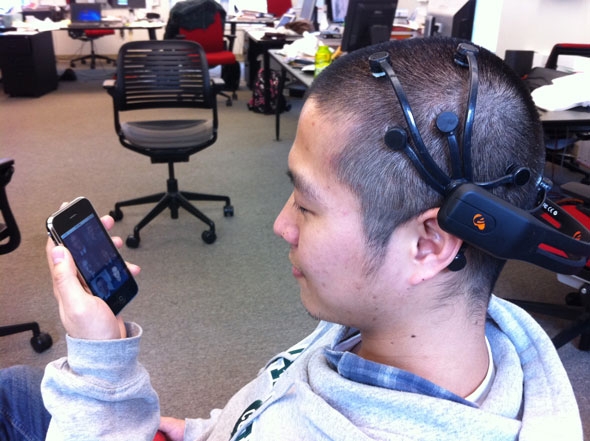Andrew Campbell, professor of computer science, Tanzeem Choudhury, assistant professor of computer science, and Rajeev Raizada, research assistant professor at the Neukom Institute for Computational Science, were recently granted the National Science Foundation (NSF) Early-concept Grants for Exploratory Research (EAGER) award for further work on their neural phone device.
The grant is to further develop the neural phone, a project that enables neural signals to control mobile phones through the use of inexpensive, off-the-shelf equipment. The project is the first time that an inexpensive wireless electroencephalography (EEG) headset has been successfully integrated with a commercial smartphone to drive mobile applications.

The neural phone elicits neural signals in response to photographs of contacts displayed on a phone and calls the chosen contact without the user ever touching the phone. The device streams raw EEG signals from a neural headset to an iPhone, which uses machine learning techniques on the phone to classify a P300 neural signal to make the call.
A number of graduate and undergraduate students contributed to the development of the neural phone. Among them was Matthew Mukerjee ’10, who worked on the neural phone as his undergraduate honors thesis in the Department of Computer Science. Before beginning graduate school at Cornell University, Mukerjee presented the neural phone in New Dehli, India, at the ACM SIGCOMM’s MobiHeld workshop. “It was a great honor to be able to represent Dartmouth at such an event,” he said. The group also created a short video to demonstrate how the phone works.
The research team, whose work with the neural phone has been well received in popular technology blogs and magazines such as Popular ScienceandThe Atlantic, is spearheading new applications in healthcare, education, and social interactions where smartphone-sensing technology is the central systems component.
More broadly, Campbell foresees that new smartphone sensing applications will impact people’s everyday lives. “You can start seeing the phone as the new microscope, as it were, in this area of well-being and health,” says Campbell. “It could be used just personally, for you, or those streams can be fed to a personal care provider or a physician.”
Mukerjee believes the intersection of academia and industry that the neural phone demonstrates is crucial. “We’ve basically shown, ‘Hey, brain-controlled phones are feasible,’” says Mukerjee. “Smartphones are already used everywhere. If industry and academia can work together and provide each other with their advancements on peripherals like EEG headsets, I think that some part of neural phone will surely be integrated as a ‘must-have’ item in the future.”
[[{“type”:“media”,“view_mode”:“media_large”,“fid”:null,“attributes”:{“class”:“media-image size-full wp-image-4848 alignleft”,“typeof”:“foaf:Image”,“style”:“”,“width”:“75”,“height”:“75”,“alt”:“Dartmouth Shield”}}]]
Dartmouth College Press Release Contact the Office of Public Affairs (603) 646-3661 • office.of.public.affairs@dartmouth.edu